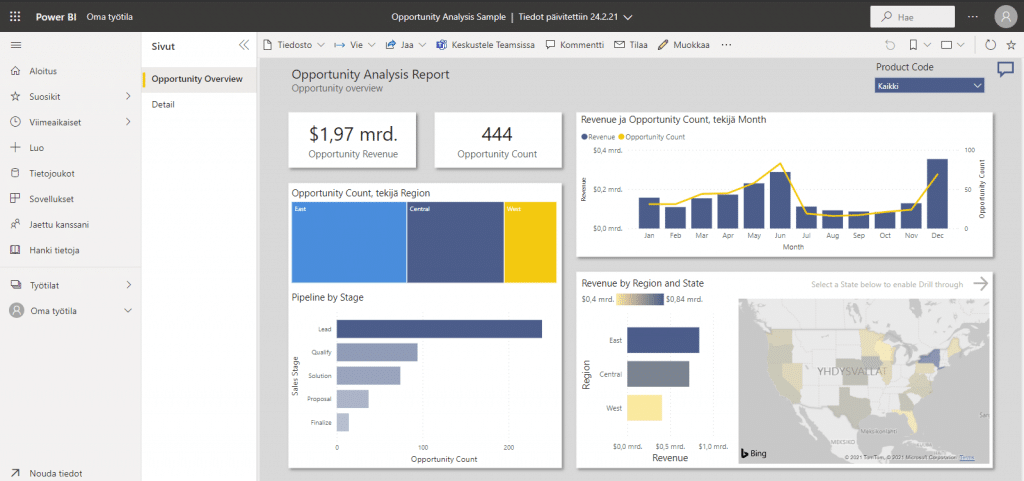Business Intelligence solutions such as Microsoft Power BI can make the daily life of a controller easier by freeing up time to support management and decision-making, improving business competitiveness and creating competitive advantage.
The job description of the person working in the role of an organization’s controller is often broad, covering participation in budgeting, reporting, and analysis of business information, as well as supporting decision-making and management.
This usually means that the main task of the controller is to produce business information for the company’s management and to guide the management in decision-making as well as in the planning of concrete actions in the right direction.
It is therefore important that the controller has the most accurate and up-to-date information available on the company’s operations and any changes that may affect it. The controller must be able to rely on that the information is not inaccurate or out of date.
The most diverse and up-to-date picture of the company’s financial situation and the development of the business and its operating environment helps the controller and the company’s management in decision-making and business development.
The harsher reality of a controller
In fact, the situation is often different, and reporting and forecasting, for example, are rarely in order. Often, controller tasks are repetitive, manual tasks that handle large amounts of data, making the job slow and laborious. The data are separate and distributed in different systems, and the data is not in a analyzed form directly ready for analysis.
With the foundations of business intelligence management and information management in a bad state, the controller has little time left for anything other than to:
- transfer data from one system to another
- check the quality and accuracy of the information
- modify the data into the format to be analyzed.
Thus, time is spent on producing and processing data, not so much on analyzing and forecasting.
Manual work prone to human errors in data storage and processing has an immediate impact on business productivity, profitability, and competitiveness, for example, as:
- slower decision-making process
- costs increase
- loss of revenues.
With existing solutions, producing the requested data, reports, and analyzes might be too complex, laborious, slow, or even impossible, which can lead to work not being done at all.

Power BI supporting controller in everyday use
Microsoft’s Power BI tool enables easy and fast publishing, updating, and analysis of reports to support the reporting and analysis of business key figures. Power BI’s comprehensive business analysis, reporting, and visualization models streamline day-to-day work. With Power BI, business information management along with BI reporting is an effortless self-service independent of time and place.
Reliable and real-time information automated with Power Automate workflows and easy-to-use Power Apps mobile forms ensures that the right information is available regardless of time, place and device.
Power BI tool:
- Simplifies reporting
- You can filter up-to-date, easy and clear data from reports created with Power BI and, if necessary, delve deeper into the underlying data.
- Facilitates visualization of business information
- Visual reports published for each user group, for example for Teams applications or SharePoint pages, improve the utilization of readily available business-critical information in everyday use.
- Enhances data analysis and improves forecasting
- Instead of producing and processing information, the time spent by employees focuses on analysis and forecasting, when information is automatically available at the right time, and rapid testing of different scenarios is possible.
- Reduces the risk of human error
- A clearly defined and modeled data warehouse serves as the basis for the automation of data production and processing, which also reduces the risks of correcting costly errors and deficiencies.
- Accelerate decision-making and improve organizational leadership
- Power BI solutions increase work productivity with automated reports and up-to-date, easy and clear data to analyze, improving an organization’s ability to respond to change with light or in-depth analytics.
When all manual data work, reporting and analysis is automated and the figures needed by the controller are displayed with just a few clicks, the controller can focus on the most important tasks as strategic support to the company’s management when interpreting key figures to management.
The Power BI system, which provides up-to-date and reliable information, concentrates all the controller’s work in one application, from budgeting and reporting to analysis and forecasting. The evergreen technologies offered by Microsoft offer flexibility and room for expansion as needs change and grow.
Power BI and data warehousing as a basis for information management
For example, the production of additional special calculations and ad hoc analyzes and forecasts to support company management’s decision-making or the preparation of financial statements and accounting is accelerated when the BI solution is built according to a clear data model and data warehouse. With a unified data layer, the data warehouse serves the information needs of different user groups better and more efficiently.
When data is loaded into a data warehouse, separate Excel files, macros, formulas, and other similar data sources that were previously combined in Excel are no longer needed. A clearly and carefully modeled and implemented data warehouse ensures easily findable and accessible information that is:
- well documented
- high quality
- in prescribed form
- time-bound.
In a well-implemented data warehouse, data is systematically modeled around different subject units one case at a time, so that the data warehouse is built as a unified entity. The information used from different sources and the information processed and combined from it guide business decision-making, as well as information management and the development of it throughout the organization information management.
A data warehouse implemented directly in the cloud database and with cloud data upload tools is an efficient, straightforward, and cost-effective way to ensure the timely availability and discoverability of data. The load capacity of source systems also remains reasonable when, for example, Azure Datalake and Azure Data Factory services are used to download source data.
Power BI and Power Platform for data management automation
Reports and data processing interfaces support data management and make managing business information easy and flexible as part of the day-to-day life of a company or organization.
In addition to Power BI reporting solutions, Power Platform tools enable process digitization. Power Automate workflows for process automation and Power Apps for data collection, processing, and storage help process data into concrete, business-friendly measures.
Automated workflows and easy-to-use forms streamline tedious, inconvenient, manual, and repetitive tasks. Automation can be used to increase the efficiency of data discovery, collection, management, and utilization.
For example, for budgets and other forecasts, you can create a report application that reads data using a Power Apps form.
For more examples of the benefits of Business Intelligence solutions, check out our customer stories:
- KUUMA-ICT & Solu Digital: Agile Business Intelligence solves billing challenges
- Transmeri & Solu Digital: SharePoint Online and Power Platform for seamless support of employees’ daily lives
- Scania & Solu Digital: Efficiency with easy-to-use solutions from Microsoft SharePoint, Power BI, Power Apps, Teams and Solu 365®
- Lassila & Tikanoja & Solu Digital: More efficient financial reporting with Business Intelligence solutions – watch the video:
You can also contact me or other Solu experts for questions about reporting and Business Intelligence solutions.
Jere Palanne
CTO, Partner








